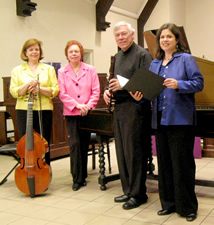The Music House is the premiere private concert venue in eastern North Carolina.
For this Friday concert, Rebecca Humphrey played a five-string piccolo cello of about 1710. Meg Owens played a modern copy of an English oboe by Bradbury. Leon Schelhase played a Ruckers-style single manual harpsichord of 2017 by North Carolina maker Ernest Miller. This fine new instrument is settling in nicely and sounds even better in an appropriate temperament, in this case Neidhardt, than it did only a few days ago in equal temperament.
Thus three fifths of “Kleine Kammermusik” performed a beautiful program of French music, German music, and pretty music at the Music House.
The beginning was a Suite in G minor arranged from works by François Chauvon (fl. 1710-40) and his teacher François Couperin (1668-1733): Chauvon’s Troisième Suite consists of a Prelude, Allemand “la dragonne,” Sarabande en rondeau “la mélancolique,” Courante “la Moisette,” Sicilienne, la Fileuse, and Le Rouët. In this performance, the Sicilienne was replaced with a harpsichord solo Allemande and an Air noblement by Couperin. The movements were all well-suited to each other, but the magic of Couperin’s style brisé was delightful. The Air noblement had, as well, a certain something that marked it as Couperin. The gigue La Rouët sparkled like a mountain trout stream flowing over rocks.
Schelhase had a solo role in Bach’s Suite No. 5 in G (S.816, alias French Suite 5). He pointed out that there is nothing French about the suite, but several early manuscript copies have the title written in French. The Courante in particular was taken at a fast speed. While there were no wrong notes, there were one or two missing ones. Overall the effect, missing notes and all, was magically musical. The Sarabande was taken at a very contrasting slow pace, with distinctive ornamental additions in the second repeat, including the seldom-heard alternative measures in the second part, known from an early manuscript and likely a clear indication of how repeats were varied. The very musical playing of the final Gigue neatly erased the minor mistakes of another missing note or two. The Miller Ruckers, a powerful instrument, filled the room with the joyous sound of Bach and Schelhase.My old edition of Schmieder’s Thematisches Verzeichnis does not list S.1033b. Owens’ program notes list the movements as [unnamed], Siciliano, Presto, and Gigue. Schelhase spoke briefly about this work as bringing the harpsichord from a continuo instrument into a fully equal musical role. He and Owens certainly played as equals, very accomplished equals. The oboe is to me a wonderful instrument; I do not agree with Shakespeare’s sentiments in Othello, Act III, Scene 1. I love the oboe’s duck-like tuneful quacking, especially that of the Baroque oboe, which has a much more realistic sound than the modern orchestral oboe, smooth and devoid of personality. Owens is the master of the Baroque oboe. Her ability to play it in tune and without squeaks was amply demonstrated in this sonata. The Old Gold slogan of fifty-odd years ago* has been turned by Owens into a clear fact: Not a squeak in a shipload. In addition, her ability to play both very soft and very loud without intonation problems is truly remarkable.
Humphries was right beside Schelhase and Owens in mastery of her piccolo cello or violincello da stalla, which she played in conventional cello fashion between her legs and and not braced under her chin with a strap. Her instrument had conventional cello tuning plus an e-string at the top to extend the range. She explained that bringing this instrument meant she could play both solo parts, as doubling the melody line in the opening Chauvon suite, and doubling the bass line in the pieces that were written with basso continuo.
Schelhase asked rhetorically, “What is a composition by Italian Giovanni Benedetto Platti doing in a program of French and German music?” then answered that the Platti had been chosen because it was pretty. That was certainly the case and a fine selection to end a fine evening.
Kleine Kammermusik’s performance was very much a high point of the season, even on the high plane of Music House musicians. Their historically informed performance produced a sound that was crisp and bright, filled with color, and non-stop delightful.
*”Not a Cough in a Carload”











